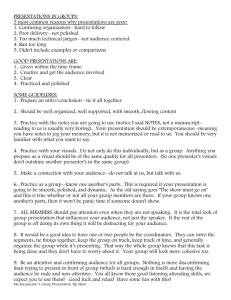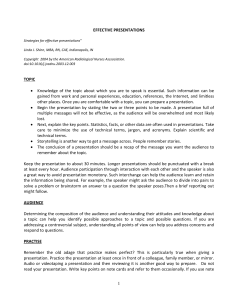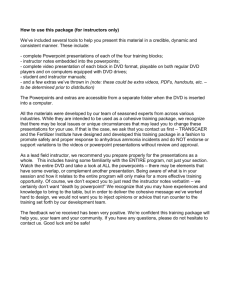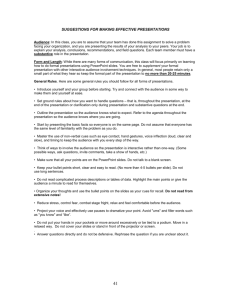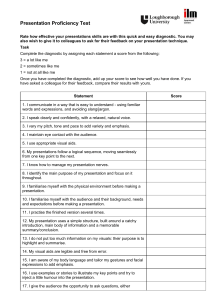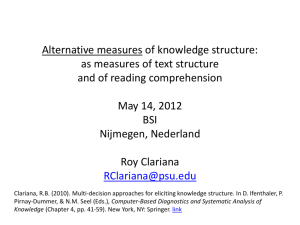Developing Effective Training Presentations
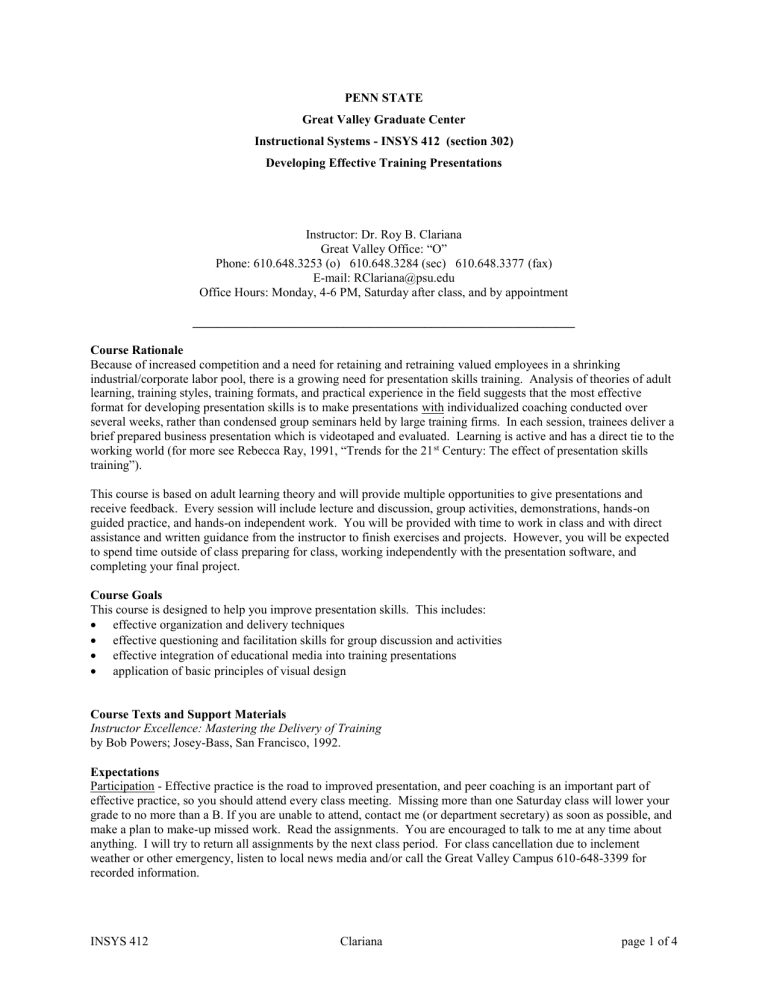
PENN STATE
Great Valley Graduate Center
Instructional Systems - INSYS 412 (section 302)
Developing Effective Training Presentations
Instructor: Dr. Roy B. Clariana
Great Valley Office: “O”
Phone: 610.648.3253 (o) 610.648.3284 (sec) 610.648.3377 (fax)
E-mail: RClariana@psu.edu
Office Hours: Monday, 4-6 PM, Saturday after class, and by appointment
_____________________________________________________________
Course Rationale
Because of increased competition and a need for retaining and retraining valued employees in a shrinking industrial/corporate labor pool, there is a growing need for presentation skills training. Analysis of theories of adult learning, training styles, training formats, and practical experience in the field suggests that the most effective format for developing presentation skills is to make presentations with individualized coaching conducted over several weeks, rather than condensed group seminars held by large training firms. In each session, trainees deliver a brief prepared business presentation which is videotaped and evaluated. Learning is active and has a direct tie to the working world (for more see Rebecca Ray, 1991, “Trends for the 21 st Century: The effect of presentation skills training”).
This course is based on adult learning theory and will provide multiple opportunities to give presentations and receive feedback. Every session will include lecture and discussion, group activities, demonstrations, hands-on guided practice, and hands-on independent work. You will be provided with time to work in class and with direct assistance and written guidance from the instructor to finish exercises and projects. However, you will be expected to spend time outside of class preparing for class, working independently with the presentation software, and completing your final project.
Course Goals
This course is designed to help you improve presentation skills. This includes:
effective organization and delivery techniques
effective questioning and facilitation skills for group discussion and activities
effective integration of educational media into training presentations
application of basic principles of visual design
Course Texts and Support Materials
Instructor Excellence: Mastering the Delivery of Training by Bob Powers; Josey-Bass, San Francisco, 1992.
Expectations
Participation - Effective practice is the road to improved presentation, and peer coaching is an important part of effective practice, so you should attend every class meeting. Missing more than one Saturday class will lower your grade to no more than a B. If you are unable to attend, contact me (or department secretary) as soon as possible, and make a plan to make-up missed work. Read the assignments. You are encouraged to talk to me at any time about anything. I will try to return all assignments by the next class period. For class cancellation due to inclement weather or other emergency, listen to local news media and/or call the Great Valley Campus 610-648-3399 for recorded information.
INSYS 412 Clariana page 1 of 4
Academic Integrity - “Academic integrity is the pursuit of scholarly activity free from fraud and deception and is an educational objective of this institution. Academic dishonesty includes, but is not limited to, cheating, plagiarizing, fabricating of information or citations, facilitating acts of academic dishonesty by others, having unauthorized possession of examinations, submitting work of another person or work previously used without informing the instructor, or tampering with the academic work of other students. At the beginning of each course it is the responsibility of the instructor to provide a statement clarifying the application of academic integrity to that course.”
(from 1989-1990 Policies and Rules for Students, p.25). Violation will likely result in a failing grade for the assignment or course. Even though academic dishonesty, plagiarism, or any form of cheating is not tolerated, cooperation and sharing information among students is recommended and encouraged.
Special Services - Special services are available to students with disabilities. “The Pennsylvania State University encourages qualified persons with disabilities in its programs and activities. If you anticipate needing any type of accommodation or have questions about the physical access provided, please contact Kathy Mingioni (610-648-
3315) in advance of your participation or visitation.”
Grading - There are several scored activities (see table below). Final letter grades will follow the convention:
A 92 - 100%
A
-
90 - 91%
B
+
88 - 89%
C
+
78 - 79%
B 82 - 87%
C 70 - 77%
B
-
80 - 81%
D 60 - 69%
F 0 - 59%
Course Grades
Portfolio (20%)
Prepare and complete four mini-presentations focusing on improving organization and delivery skills
Maintain a folder of material and information related to these presentations including presentation notes, your reflections, and feedback.
Team Lesson (20%)
Facilitate a learning activity, discussion, or exercise and submit an outline of the lesson
Lesson Package (20%)
Design an instructional lesson using presentation software
The package must include a detailed facilitator’s guide, printed handouts, and electronic presentation media which a SME could use to deliver the presentation
Presentation Visuals (20%)
Demonstrate effective use of presentation media using the visuals created for your lesson package (including demo)
Class Participation (20%)
Collaborative/positive teamwork
Encourage success
In a feedback group, provide oral and sometimes written feedback to classmates
Read and be prepared to discuss assignments on the course schedule
INSYS 412 Clariana page 2 of 4
INSYS 412 Course Schedule
Date Activities
1 3/07/98 Introductions
Course Goals and Syllabus
Dealing with Anxiety
Personal Goal Setting
Providing Feedback
Project Assignment and Format
2 3/14/98 Effective Instruction
Lesson Structure
Openings and Closings
Platform Skills
Organizing Information
Designing Presentation Visuals #1
PowerPoint Lab #1
3 3/21/98 Questioning Techniques
Generating Group Discussions
Designing Presentation Visuals #2
PowerPoint Lab #2
4 3/28/98 Facilitating Learning Activities
Readings
Ch 4 and
Ch12 p147-154
Ch 1, 2, 5, 7
Ch 10
Ch 9 handout
Ch 6, 8
5 4/04/98 Team Planning
6 4/11/98
Facilitator’s Guides and Handouts
PowerPoint Lab #3
PowerPoint Lab #4
Team Presentations
Team Presentations
Processing Team Presentations
Presenting with PowerPoint
Dealing with Challenges
Course Evaluation
7 4/18/98 Presentation Visuals
Lesson Demonstrations handout
Ch 10 and
Appendix
Assignments
Presentation 1:
Introductions
Presentation 2: Effective
Learning Experience
Portfolio
Presentation 3: Using
Questions to Lead
Discussions
Thumbnails, Lesson
Package Proposal
Presentation 4: Team
Presentation
Presentation 4: Team
Presentation
Lesson Package Rough
Copy
Presentation 5: Visuals
Lesson
Portfolio / Lesson Package
INSYS 412 Clariana page 3 of 4
Course Instructor
Roy Clariana has been an Assistant Professor at Penn State Great Valley since 1997. Besides his duties for Penn
State, Roy consults in training evaluation, training design especially with standards-based education, and technology support in education and training.
Roy’s corporate experience includes eight years as a ‘fast-gun’ training consultant, and several years with EG&G,
Inc. (a Fortune 100 Company) developing and delivering numerous courses such as Basic Instructor Training, a 40hour train-the-trainer course; and On-the-Job Training, a 20-hour course for instructors focused on assessing employee work skills on the plant floor for re-certification. Roy then worked for five years for Jostens Learning
Corporation (a Fortune 500 Company) developing curriculum software and consulting with teachers and administrators in technology integration and professional staff development.
Perhaps Roy’s most interesting job was Training Director for the Peace Corps in Kenya, Malawi, and Nepal. This job required soup-to-nuts planning and implementation, and included such diverse tasks as hiring and training language teachers, technical trainers and support staff, finding training sites and housing for trainees, working with staff to develop comprehensive 12 to 14-week training experiences, interviewing witch doctors for cross-cultural sessions, taking tea with chiefs while arranging family visits, mixing cement for water projects, and repairing generators struck by lighting.
Roy and his wife Sarah, who is a professional doll maker with a Ph.D. in rhetoric and communication, live in
Royersford. They spend as much time as they can at their cabin in Colorado hosting family and friends and enjoying cool summers and Christmas ski trips.
INSYS 412 Clariana page 4 of 4

